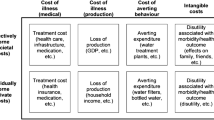Abstract
When a new drinking water regulation is being developed, the USEPA conducts a health risk reduction and cost analysis to, in part, estimate quantifiable and non-quantifiable cost and benefits of the various regulatory alternatives. Numerous methodologies are available for cumulative risk assessment ranging from primarily qualitative to primarily quantitative. This research developed a summary metric of relative cumulative health impacts resulting from drinking water, the relative health indicator (RHI). An intermediate level of quantification and modeling was chosen, one which retains the concept of an aggregated metric of public health impact and hence allows for comparisons to be made across “cups of water,” but avoids the need for development and use of complex models that are beyond the existing state of the science. Using the USEPA Six-Year Review data and available national occurrence surveys of drinking water contaminants, the metric is used to test risk reduction as it pertains to the implementation of the arsenic and uranium maximum contaminant levels and quantify “meaningful” risk reduction. Uranium represented the threshold risk reduction against which national non-compliance risk reduction was compared for arsenic, nitrate, and radium. Arsenic non-compliance is most significant and efforts focused on bringing those non-compliant utilities into compliance with the 10 μg/L maximum contaminant level would meet the threshold for meaningful risk reduction.




Similar content being viewed by others
References
Alfredo, K., Seidel, C., & Roberson, J. A. (2014). Reviewing the occurrence data used in the revised arsenic rule. Journal of American Water Works Association, 106, 139–149.
Alfredo, K.A., Ghosh, A., Seidel, C., Roberson, J.A., n.d.. How does a future carcinogenic VOC regulation affect the national drinking water risk cup? Submitt. to Environ. Monit. Assess.
Burkart, W., & Jung, T. (1998). Health risks from combined exposures: mechanistic considerations on deviations from additivity. Mutation Research, 411, 119–128.
Crawford-Brown, D., & Crawford-Brown, S. (2012). Cumulative risk assessment framework for waterborne contaminants. Journal of Environmental Protection (Irvine,. Calif), 3, 400–413. doi:10.4236/jep.2012.35050.
Dourson, M. L., Felter, S. P., & Robinson, D. (1996). Evolution of science-based uncertainty factors in noncancer risk assessment. Regulatory Toxicology and Pharmacology, 24, 108–120. doi:10.1006/rtph.1996.0116.
Mathers, C. D., Lopez, A. D., & Murray, C. J. L. (2006). Chapter 3 the burden of disease and mortality by condition: data, methods, and results for 2001. In A. D. Lopez, C. D. Mathers, & M. Ezzati (Eds.), Global burden of disease and risk factors (pp. 45–93). Washington, D: World Bank.
National Research Council, 2001. Arsenic in drinking water: 2001 update. Washington, D.C.
President’s Council of Advisors on Science and Technology, 2016. Report to the president: science and technology to ensure the safety of the nation’s drinking water. Washington, D.C.
Seidel, C.J., Ghosh, A., Tang, G., Hubbs, S.A., Raucher, R.S., Crawford-Brown, D., 2014. Identifying meaningful opportunities for drinking water health risk reduction in the United States, Report #4310. Denver.
Sexton, K. (2012). Cumulative risk assessment: an overview of methodological approaches for evaluating combined health effects from exposure to multiple environmental stressors. International Journal of Environmental Research and Public Health, 9, 370–390. doi:10.3390/ijerph9020370.
Soskolne, C. L., & Broemling, N. (2002). Eco-epidemiology on the need to measure health effects from global change. Global Change and Human Health, 3, 58–66.
Teuschler, L. K., & Hertzberg, R. C. (1995). Current and future risk assessment guidelines, policy, and methods development for chemical mixtures. Toxicology, 105, 137–144.
USEPA, 1997. Guidance on cumulative risk assessment. Part 1. Planning and scoping. Washington, D.C.
USEPA, 2000. Data reliability analysis of EPA safe drinking water inforamtion system/federal version. Washington, D.C.
USEPA, 2003. EPA protocol for the review of existing national primary drinking water regulations. Washington, D.C.
USEPA, n.d. USEPA risk assessment [WWW Document]. URL http://www.epa.gov/risk#r (accessed 7.14.13).
USEPA Science Advisory Board, 2000. Toward integrated environmental decision-making. Washington, D.C.
WHO, 2008. The global burden of disease 2004. Geneva.
Wilkinson, C. F., Christoph, G. R., Julien, E., Kelley, J. M., Kronenberg, J., McCarthy, J., & Reiss, R. (2000). Assessing the risks of exposures to multiple chemicals with a common mechanism of toxicity: how to cumulate? Regulatory Toxicology and Pharmacology, 31, 30–43. doi:10.1006/rtph.1999.1361.
Williams, P. R. D., Dotson, G. S., & Maier, A. (2012). Cumulative risk assessment (CRA): transforming the way we assess health risks. Environmental Science and Technology, 46, 10868–10874. doi:10.1021/es3025353.
Acknowledgements
This project was funded through the Water Industry Technical Action Fund (WITAF). Administered by AWWA, WITAF is financed by the dues of AWWA’s organizational members. WITAF provides funding for information collection and analysis and other activities in support of sound and effective legislation, regulation, and drinking water policies and programs.
Author information
Authors and Affiliations
Corresponding author
Electronic supplementary material
ESM 1
(PDF 296 kb)
Rights and permissions
About this article
Cite this article
Alfredo, K.A., Seidel, C., Ghosh, A. et al. Using a relative health indicator (RHI) metric to estimate health risk reductions in drinking water. Environ Monit Assess 189, 124 (2017). https://doi.org/10.1007/s10661-017-5815-8
Received:
Accepted:
Published:
DOI: https://doi.org/10.1007/s10661-017-5815-8




